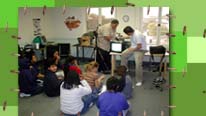Build
their story:
Having discussed their answers, we can now begin to build a story.
Encourage your students to use their answers as "research"
into the story that they will write. They'll be surprised to know
that half their job is already done, and they'll like that. You
see, they have intuitively gone through the process of outlining
a narrative, of sketching events and relationships that will later
on become part of a larger universe: a story.
Refer to Standards 1.0 Writing
Strategies
It is interesting to note that creative writing classes attempt
to achieve this end through different means. Our process unlocks
the student's imagination, allowing them to recognize that the
process of creating a story is quite natural to them.
Now, everyone can write a story, but not everyone trusts that
their choices and fancies are the right ones to take.
Refer to Standards 2.0 Writing
Applications (Genres and Their Characteristics)
We need to help students trust themselves, assisting them to connect
their prior knowledge to current activities.
Once the story has been written, the teacher can explore different
ways to translate it into a selected medium : theater, video or
to continue fleshing out the story as a literary work.
Inter: Re-Active participants used Flash Macromedia - a vector
based graphics tool for the web - to animate their story.
Student examples:



